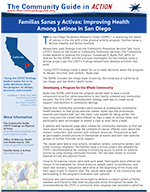Familias Sanas y Activas: Improving Health among Latinos in San Diego
Summary
 The San Diego Prevention Research Center is improving the health of Latinos in the city with a free physical activity program. Weekly exercise classes are held throughout the community. (Released 2015)
The San Diego Prevention Research Center is improving the health of Latinos in the city with a free physical activity program. Weekly exercise classes are held throughout the community. (Released 2015)Lessons Learned
- Share the knowledge. The San Diego Prevention Research Center (SDPRC) shared Task Force findings with its community partners so everyone involved could see which interventions would be most effective in changing health behaviors and health status.
- Make adjustments as needed. Ayala said they learned that outdoor classes were not popular because participants preferred to exercise in a private setting. Classes were offered indoors instead.
- Remember the volunteers. Promotoras can become discouraged when participation is low in their classes. Booster trainings were offered on a consistent basis to keep the promotoras engaged and inspired.
Story
Researchers used findings from the Community Preventive Services Task Force (Task Force) found on the Guide to Community Preventive Services (The Community Guide) website to develop the program. Guadalupe X. Ayala, PhD, MPH, co-director for the SDPRC and the principal investigator for the Familias Sanas y Activas project says the Task Force’s findings helped them develop activities that work.
“Using Task Force findings made it easier for us to make decisions about the program, its design, structure, and content,” Ayala says.
The SDPRC includes San Diego State University, the University of California at San Diego, and San Ysidro Health Center.
Developing a Program for the Whole Community
Ayala says SDPRC staff knew the program would need to have a social component since the Latino population is very family-oriented and community focused. The first Task Force recommended strategy used was to create social support interventions in community settings.
Twenty-four community volunteers were trained as promotoras (community health workers) to lead group exercise classes. Ayala says the promotoras ensured participants had “just like them” role models for being active. The hour-long exercise classes were offered six days a week at various times, and participants were encouraged to attend a class at least twice a week.
A website and Facebook page were created for community members to find out more about the program, view the schedule of classes offered, learn about the classes’ instructors, and connect with relevant resources. Promotoras as well as participants posted pictures of themselves at events and with their exercise groups to further illustrate social support.
The classes were held at local schools, recreation centers, community centers, and public housing complexes. The Familias Sanas y Activas project also adopted the Task Force’s recommendation for creating or enhancing access to places for physical activity by using existing community facilities. This has been shown to increase physical activity and physical fitness.
Close to 50 exercise classes were held each week. Participants were offered the chance to be evaluated for: blood pressure, weight, waist circumference, and heart rate recovery. Evaluations were done at the beginning of the study and then again 6 and 12 months later. The classes were open to the community and participating in the program’s evaluation was optional.
Everyone who participated was encouraged to develop a support system of family members and friends to help them be physically active throughout the week. As recommended by the Task Force, a community-wide campaign was launched to advertise the program and physical activity opportunities. Presentations were given at schools, community health fairs, and other community events.
The Task Force’s recommendation for individually-adapted health behavior change programs helped the SDPRC staff understand the importance of basic behavior change skills, such as goal setting and self-monitoring. An optional, 11-session healthy lifestyle program was offered in addition to the regular exercise classes. Self-esteem, weight control, and healthy eating were a few of the topics covered in that program.
Promising Results
Four hundred and forty-two Latinas agreed to participate in the evaluation study. At the start of the study, 45 percent of those women were obese, 44 percent were prehypertensive, and 8.5 percent were hypertensive. Prehypertensive means having slightly higher than normal blood pressure, which increases the risk of developing high blood pressure in the future.
Participants experienced an average decrease of 1.4 mmHg in systolic blood pressure and 1.5 mmHg in diastolic blood pressure in the first six months of the program. Also, during the first six months, their weight decreased by an average of 2.4 pounds with waist circumference decreasing by an average of 2 centimeters. Improvements in fitness were demonstrated by an average decrease in heart rate recovery of 5.45 beats per minute within 12 months of participating in the project.
Obesity is a risk factor for heart disease, which is the second leading cause of death among Latinos.1 Programs like Familias Sanas y Activas can help prevent and control obesity among this population.
*In 1984, Congress authorized the U.S. Department of Health and Human Services (HHS) to create a network of academic health centers to conduct practical public health research. The Centers for Disease Control and Prevention (CDC) was selected to provide leadership, technical assistance, and oversight for this network, which is called the Prevention Research Centers (PRC) Program. Each center conducts at least one core research project with an underserved population that has high rates of disease and disability. SDPRC is a formerly-funded PRC.
1Hispanic health infographic. CDC Vital Signs May 2015. Available from: www.cdc.gov/vitalsigns/hispanic-health/infographic.html. Accessed May 2015.
More Information
Institute for Behavioral and Community Health (IBACH)
San Diego Prevention Research Center
Community Preventive Services Task Force findings referred to in this story:
The Community Guide: Task Force Findings on Physical Activity